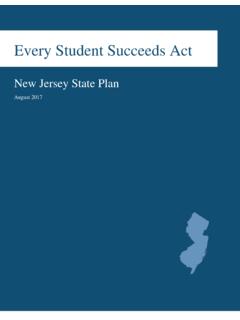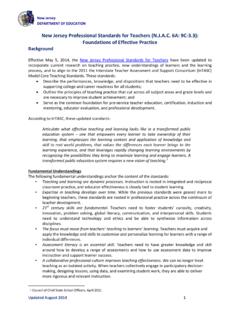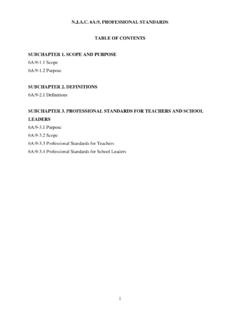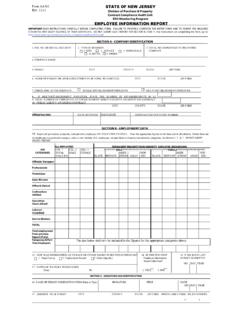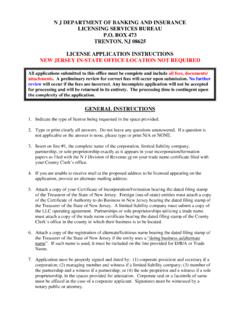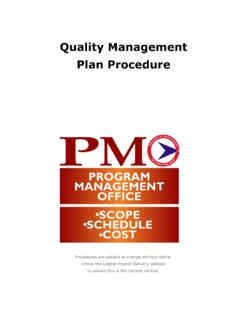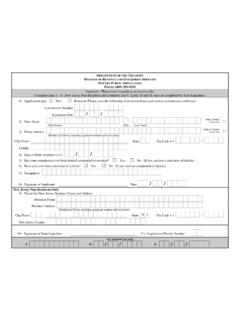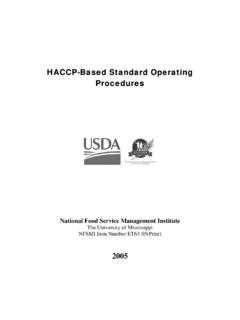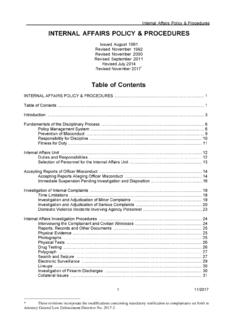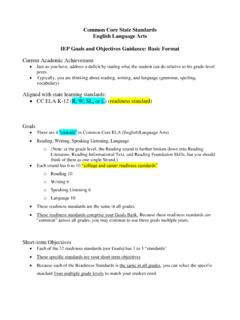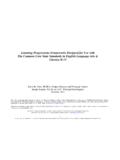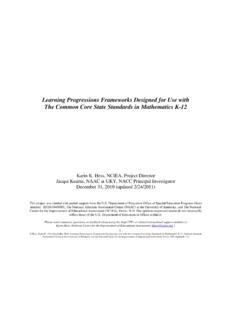Transcription of New Jersey Student Learning Standards for Comprehensive ...
1 Summary of Revisions to the 2014 NJSLS for Comprehensive Health and Physical Education There were minor changes made to the 2014 Standards . Additions to the Standards included the following defining terms in the glossary: overload principle, progressive principle, principle of specificity, health, wellness, rhythm and health data. Newly passed legislation 18A: describing dating violence education in grades 7-12, was added to the legislation section. One additional revision included in the revised document was the addition to the existing definition of 21st Century Skills by the Partnership of 21st Century Skills. The phrase Understanding national and international public health and safety issues was added to the existing definition. New Jersey Student Learning Standards for Comprehensive Health and Physical Education INTRODUCTION Comprehensive Health and Physical Education in the 21st Century Health literacy is an integral component of 21st century education.
2 Healthy students are learners who are knowledgeable, productive, and also emotionally and physically healthy, motivated, civically engaged, prepared for work and economic self-sufficiency, and ready for the world beyond their own borders (ASCD, 2004). As part of the state s initiative to prepare students to function optimally as global citizens and workers, the contemporary view of health and physical education focuses on taking personal responsibility for one s health through an active, healthy lifestyle that fosters a lifelong commitment to wellness. The mission and vision for Comprehensive health and physical education reflects this perspective: Mission: Knowledge of health and physical education concepts and skills empowers students to assume lifelong responsibility to develop physical, social, and emotional wellness. Vision: A quality Comprehensive health and physical education program fosters a population that: Maintains physical, social, and emotional health by practicing healthy behaviors and goal setting.
3 Engages in a physically active lifestyle. Is knowledgeable about health and wellness and how to access health resources. Recognizes the influence of media, technology, and culture in making informed health-related decisions as a consumer of health products and services. Practices effective cross-cultural communication, problem solving, negotiation, and conflict resolution skills. Is accepting and respectful of individual and cultural differences. Advocates for personal, family, community, and global wellness and is knowledgeable about national and international public health and safety issues. Intent and Spirit of the Comprehensive Health and Physical Education Standards All students participate in a Comprehensive , sequential, health and physical education program that emphasizes the natural interdisciplinary connection between wellness and health and physical education. The Standards provide a blueprint for curriculum development, instruction, and assessment that reflects the latest research-based platform for effective health and physical education programs.
4 The primary focus of the Standards is on the development of knowledge and skills that influence healthy behaviors within the context of self, family, school, and the local and global community. The 2014 revised Standards incorporate the current thinking and best practices found in health and physical education documents published by national content-specific organizations as well as public health and other education organizations and agencies. Revised Standards The Comprehensive Health and Physical Education Standards provide the foundation for creating local curricula and meaningful assessments. Revisions to the Standards include cumulative progress indicators that reflect: o Recently enacted legislation outlined in the section below o An emphasis on health literacy, a 21st century theme o Global perspectives about health and wellness through comparative analysis of health-related issues, attitudes, and behaviors in other countries o Inclusion of additional skills related to traffic safety, fire safety, and accident and poison prevention o Increased awareness of and sensitivity to the challenges related to individuals with disabilities The 2014 Standards continue to incorporate New Jersey Legislative Statutes related to the health and well-being of students in New Jersey public schools, including those enacted from 2009-2014: Dating Violence Prevention Bill: 18 a (2010) requires instruction in dating violence prevention.
5 CPR/ AED Instruction Bill: 18 (2014) requires public high schools to provide instruction in cardiopulmonary resuscitation and the use of an automated external defibrillator to each Student prior to graduation. Health Literacy includes: Obtaining, interpreting, and understanding basic health information and services and using such information and services in ways that are health enhancing. Understanding preventive physical and mental health measures, including proper diet, nutrition, exercise, risk avoidance, and stress reduction. Using available information to make appropriate health-related decisions. Establishing and monitoring personal and family health goals. Understanding national and international public health and safety issues. (Partnership for 21st Century Skills, 2009) New Jersey Legislative Statutes Summary Accident and Fire Prevention ( 18A:6-2) requires instruction in accident and fire prevention.
6 Regular courses of instruction in accident prevention and fire prevention shall be given in every public and private school in this state. Instruction shall be adapted to the understanding of students at different grade levels. Breast Self-Examination ( 18 ) requires instruction on breast self-examination. Each board of education which operates an educational program for students in grades 7 through 12 shall offer instruction in breast self-examination. The instruction shall take place as part of the district s implementation of the Core Curriculum Content Standards in Comprehensive Health and Physical Education, and the Comprehensive health and physical education curriculum framework shall provide school districts with sample activities that may be used to support implementation of the instructional requirement. Bullying Prevention Programs ( 18A:37- 17) requires the establishment of bullying prevention programs. Schools and school districts are encouraged to establish bullying prevention programs and other initiatives involving school staff, students, administrators, volunteers, parents, law enforcement, and community members.
7 To the extent funds are appropriated for these purposes, a school district shall: (1) provide training on the school district s harassment, intimidation, or bullying policies to school employees and volunteers who have significant contact with students; and (2) develop a process for discussing the district s harassment, intimidation, or bullying policy with students. Information regarding the school district policy against harassment, intimidation, or bullying shall be incorporated into a school s employee training program. Cancer Awareness ( 18A:40-33) requires the development of a school program on cancer awareness. The Commissioner of Education, in consultation with the State school boards, shall develop a cancer awareness program appropriate for school-aged children. Dating Violence Education ( 18A: ) requires instruction regarding dating violence in grades 7-12. Each school district shall incorporate dating violence education that is age appropriate into the health education curriculum as part of the district s implementation of the Core Curriculum Content Standards in Comprehensive Health and Physical Education for students in grades 7 through 12.
8 The dating violence education shall include, but not be limited to, information on the definition of dating violence, recognizing dating violence warning signs, and the characteristics of healthy relationships. Domestic Violence Education ( 18 ) allows instruction on problems related to domestic violence and child abuse. A board of education may include instruction on the problems of domestic violence and child abuse in an appropriate place in the curriculum of elementary school, middle school, and high school pupils. The instruction shall enable pupils to understand the psychology and dynamics of family violence, dating violence, and child abuse; the relationship of alcohol and drug use to such violence and abuse; and the relationship of animal cruelty to such violence and abuse; and to learn methods of nonviolent problem-solving. Gang Violence Prevention (18 ) requires instruction in gang violence prevention for elementary school students.
9 Each board of education that operates an educational program for elementary school students shall offer instruction in gang violence prevention and in ways to avoid membership in gangs. The instruction shall take place as part of the district s implementation of the Core Curriculum Content Standards in Comprehensive Health and Physical Education, and the Comprehensive health and physical education curriculum framework shall provide school districts with sample materials that may be used to support implementation of the instructional requirement. Health, Safety, and Physical Education ( :35) requires that all students in grades 1 through 12 participate in at least two and one-half hours of health, safety, and physical education in each school week. Every pupil, except kindergarten pupils, attending the public schools, insofar as he or she is physically fit and capable of doing so, as determined by the medical inspector, shall take such courses, which shall be a part of the curriculum prescribed for the several grades, and the conduct and attainment of the pupils shall be marked as in other courses or subjects, and the standing of the pupil in connection therewith shall form a part of the requirements for promotion or graduation.
10 The time devoted to such courses shall aggregate at least two and one-half hours in each school week, or proportionately less when holidays fall within the week. Drugs, Alcohol, Tobacco, Controlled Dangerous Substances, and Anabolic Steroids ( 18A:40A-1) requires instructional programs on drugs, alcohol, anabolic steroids, tobacco, and controlled dangerous substances and the development of curriculum guidelines. Instructional programs on the nature of drugs, alcohol, anabolic steroids, tobacco, and controlled dangerous substances, as defined in section 2 of , ( :21-2), and their physiological, psychological, sociological, and legal effects on the individual, the family, and society shall be taught in each public school and in each grade from kindergarten through 12 in a manner adapted to the age and understanding of the pupils. The programs shall be based upon the curriculum guidelines established by the Commissioner of Education and shall be included in the curriculum for each grade in such a manner as to provide a thorough and Comprehensive treatment of the subject.
